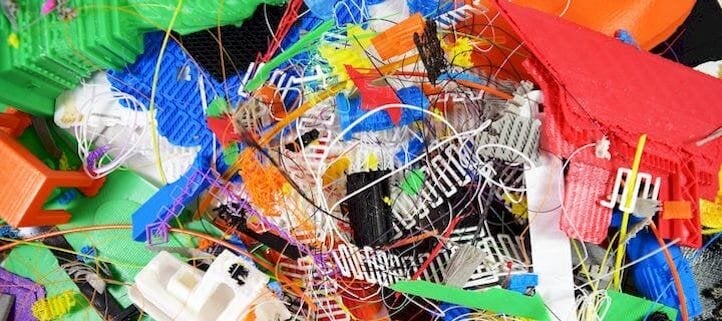![Plastic scraps leftover from 3D printing operations [Source: RePLAy 3D]](https://fabbaloo.com/wp-content/uploads/2020/05/image-asset_img_5eb08bf1dd584.jpg)
We received some new information from RePLAy 3D.
They are a 3D print waste material recycling service that actually works, and there’s no other service quite like it. Here’s how it works:
-
Purchase one of their 100% Recycled Filaments
-
Save the box your filament arrives in. You will use it to send you scraps back to RePLAy 3D
-
Place bad prints, rafts, supports and other scraps into the shipping box
-
Request a pre-paid shipping label
-
Place label on your box and send
Seems pretty straightforward, and there’s little effort required. We first covered RePLAy 3D well over a year ago, but since then we’ve obtained some further information.
We were contacted by Joe Shamatta of RePLAy 3D who offered some clarifications and new information to add to our speculations.
In the earlier story, Fabbaloo said: The PLA spools are NOT made from the recycled material you send back to Replay 3D. This is not unexpected, because I foresee tremendous technical challenges in actually reusing returned material. The scraps may be “PLA”, but they could easily be of a slight different chemistry if not all originate with a single source.
Joe Shamatta: This is correct but not for the reasons you’ve assumed. The scrap we receive is fine for recycling and reintroduction into recycled filament. Most PLA used in 3D extrusion will have similar specs and work well for recycled filaments.
Our issue has been collecting enough volume of scraps to grind and send to our manufacturer. We are currently working with local plastic compounders to take what we have and reprocess the regrinds into pellets.
In the earlier story, Fabbaloo said: My guess is that they might take all the returned material and ship it off to an industrial recycler equipped to boil off the dyes and re-purify the material into raw PLA. Whatever process they use would likely be financially feasible only at large scales, making it unlikely Replay 3D would do this themselves.
Joe Shamatta: This is not how recycling works. You do not boil off the dyes; you blend all the colors together and add black dye. You also cannot re-purify into raw material. The compounders we are working with will process the scrap we provide into what’s called “repro,” which is short for “reprocessed.” This repro is dyed black and can contain some impurities but due to the compounding process and blending, those impurities can be filtered out of the final product.
In the earlier story, Fabbaloo said: Another darker possibility is that Replay 3D might simply drop the materials off at their local city recycling depot. I’m really hoping they would not do that, as the originator of the scraps could simply do the same in their home city without requiring transport of materials.”
Joe Shamatta: We definitely do not do this. Our parent company, 3R Recycling, is an industrial recycler and we process everything we get in-house with little to no waste. We would never drop materials to our local recycling depot, especially since PLA and ABS are not accepted at most municipal MRF.
With those clarifications known, perhaps you’d like to try a true “closed loop” recycled filament offering? Currently RePLAy 3D offers recycled ABS and PLA filaments, as well as non-recycled PLA+, metal-infused, translucent, water-soluble and flexible filaments at reasonable prices.
Via RePLAy 3D

